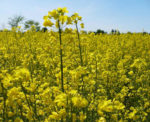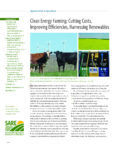The educational materials listed on this page are about Biofuel Feedstocks.
There are a number of different kinds of crops besides corn that can be used as feedstocks for producing biofuel. Biofuel feedstocks produce starches or sugars that can be converted to produce ethanol, while others produce oil that can be used in biodiesel production. The types of biofuel are widely varied, and likewise there are many different biofuel sources. Biomass, unlike other renewable energy, can be converted into liquid biofuels to help meet transportation fuel needs. These different sources of biofuel from biofuel crops are used to make various biofuels, such as camelina, ethanol from corn, sugarcane ethanol, algae biofuel and canola oil biodiesel, and are essential for biofuel feedstock. Key practices include the use of agronomic crops, byproduct utilization, bioenergy and biofuels, anaerobic digestion, biodiesel, biofuel feedstocks, nutrient cycling, municipal wastes, renewable energy.
SARE’s book Building a Sustainable Business helps farmers build both a sustainable and profitable business plan that includes renewable energy and biofuel. The SARE bulletin Clean Energy Farming: Cutting Costs, Improving Efficiencies, Harnessing Renewables helps farmers utilize clean energy practices on their operations, which may include utilizing byproducts for biodiesel production and other renewable fuels. In the SARE video Energy Independence: On-Farm Biodiesel Fuel Production, Vermont farmer Roger Rainville describes how he grows oilseed crops such as sunflower and canola as biofuel feedstocks. The Farm Energy Topic Room provides a wealth of information on clean energy topics, including biodiesel, farm energy audits, solar and wind energy, and more.
Showing 1-5 of 5 results

Sustainable Production and Use of On-Farm Energy
Using solar or wind energy or producing biofuels from crop feedstocks and anaerobic digestion helps farmers achieve energy independence while improving profitability and reducing fossil fuel emissions.

The Sustainability of Biofuel Fact Sheet Series
This 18-part series addresses topics related to the sustainability of biofuel production, including biodiversity, greenhouse gas reductions, life cycle analysis and more.

Energy Independence: On-Farm Biodiesel Fuel Production
Roger Rainville is ahead of the curve when it comes to reducing costs on his farm near Alburgh, Vt. He’s currently producing biodiesel from canola and sunflower for about $1.70 a gallon.

Growing Biodiesel Crops: A Couple of Tips
In this short video, Rainville describes his philosophy for trying something new on your farm. It’s all about making the most of the learning curve.

Clean Energy Farming
Clean Energy Farming: Cutting Costs, Improving Efficiencies, Harnessing Renewables features innovative SARE-funded research and examples of farmers who are improving energy efficiency while saving money, implementing farming practices that both save energy and protect natural resources, and producing and using renewable fuels.